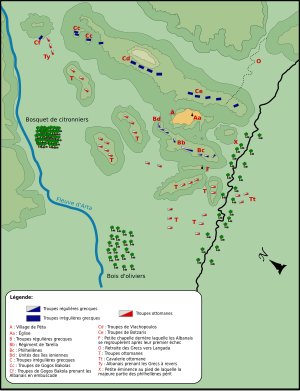Battle of Peta
| Battle of Peta | |||||||
|---|---|---|---|---|---|---|---|
| Part of the Greek War of Independence | |||||||
 Map of the Battle of Peta |
|||||||
|
|||||||
| Belligerents | |||||||
|
|
|
||||||
| Commanders and leaders | |||||||
|
Alexandros Mavrokordatos Markos Botsaris Karl von Normann-Ehrenfels |
Omer Vrioni | ||||||
| Strength | |||||||
| 2100 troops (regulars and irregulars) and 93 Philhellenes | 7000-8000 troops | ||||||
| Casualties and losses | |||||||
| 68 Philhellenes and 200 regulars dead the number of irregular casualties is not known many prisoners |
Unknown | ||||||
The Battle of Peta or Battle of Petta was fought between the Greeks (with Philhellenes) led by Alexandros Mavrokordatos with Markos Botsaris and the Ottomans led by Omer Vrioni on July 16, 1822 (July 4 Julian calendar). The conflict occurred on a hillside near the village of Peta in Epirus.
After the Souliotes defeated the forces of Khourshid Pasha in May and June 1822, they joined Prince Alexander Mavrocordatos who landed at Missolonghi with a contingent of Greek regulars. At the same time, however, Khourshid Pasha surrendered command of the Ottoman forces in Epirus to the Albanian general Omer Vrioni. Joining the Greeks were one battalion of German, Polish, Swiss, French and Italian philhellene volunteers with Karl von Normann-Ehrenfels, formerly of the Wurttemberg army, serving as Mavrokordatos's chief of staff. Several of the Italian, German and French philhellenes were veterans of the Napoleonic wars and who trained a battalion of Greeks to fight in the Western-style of war. The philhellenes were far from united and in a duel a German shot a Frenchman dead. One French philhellene Jean-François-Maxime Raybaud reported: "It was unimaginably difficult to train the men in the harsh and precise details of service in the ranks, in strict discipline and in the advantages of systematic instruction, when these men were Europeans of a generally difficult temperament and different in their habits, education, language and weapons". Mavrokordhatos's force of about 2, 000 men, both regular and irregular were outnumbered by the Ottoman force of 10, 000 Turks and Albanians. Mavrokordhatos placed his men on two ridges to the west and east of the village of Peta, which stands on a low hill at the beginning of a coastal plain. On the higher ridge to the east of the village were placed Greek forces under Gogos Bakolas on the right, forces commanded by other captains Varnakiotis and Vlachopoulos in the middle while Markos Botsaris were on the left. On the western and lower ridge were the philhellenes with the Greek regulars under the Italian captain Taralla in the middle, volunteers from the British protectorate of the Ionian islands on the right and the philhellenes under the Italian Dania on the left. Bakolas and Botsaris were old enemies, both being rival klephts (bandits) and Mavrokordhatos wanted to keep the two rivals as far as apart as possible as the two men hated on another.
...
Wikipedia
